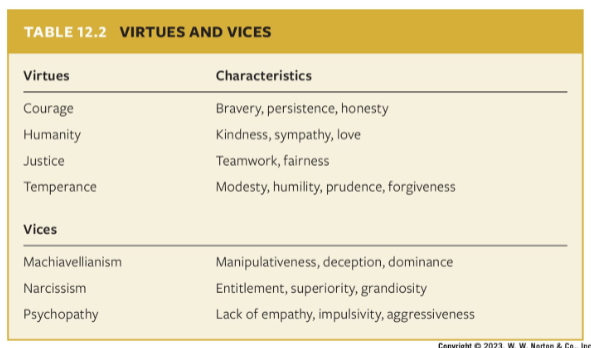Chapter 12: Groups
1/34
There's no tags or description
Looks like no tags are added yet.
Name | Mastery | Learn | Test | Matching | Spaced |
|---|
No study sessions yet.
35 Terms
Group
Two or more people who interact & are interdependent in the sense that their needs & goals cause them to influence each other
Why Do People Join Groups?
Fulfills basic human needs
Other people can be an important source of info
Groups become an important part of our identity
Groups also help establish social norms
Properties of Groups
Norms: specifies which behaviors, beliefs, and perceptions are “good” and “appropriate”
Roles: more or less well-defined expectations for one’s behavior
Cohesiveness: the “entitativity” of a group that binds its members together
Social Facilitation (old definition)
the presence of others enhances individual performance (under some circumstances)
Zajonc et al. (1969) Cockroach Study
How long does it take cockroaches in a simple maze to escape from a bright light?
Alone: 40.6 seconds
Audience: 33.0 seconds
Cockroach study using a complex maze; # of seconds to escape light
Alone: 110
Audience: 130
Dominant Response
response that is highest in your behavioral repertoire
Nondominant Response
all other responses
if you are an expert, or if the task is easy, the dominant response is to perform well
If you are not an expert, or if the task is hard, the dominant response is to screw up
Social Facilitation: Revised Definition
the presence of others increases the likelihood that dominant responses will occur
For easy or well-learned tasks, the presence of others improves performance
For difficult or unpracticed tasks, the presence of others harms performance
Why does S.F. Happen?
Mere presence → alertness → arousal
Evaluation apprehension → arousal
People’s concern about how they might appear to others, or be evaluated by them
Cottrell et al., 1968
Pronounce 2 nonsense words 1, 2, 5, 10, 25 times (manipulating practice)
More practiced words = dominant response
Pseudorecognition task alone, the presence of an attentive audience, or the presence of a blindfolded audience
DV: number of dominant responses
Evaluative: 13
Blindfolded: 9
Alone: 8.5
Why does S.F. Happen? Pt 2
Distraction → divided attention → conflict → arousal
Arousal increases the tendency to perform the dominant response
Social Facilitation: Hunt & Hillery, 1973
Performance of pool players
Good & bad pool players
Play pool while alone & while observed
Good players did better w/ an audience; bad players did worse
Social Facilitation: Does the supportiveness of the observers matter?
Home team advantage in sports:
Baseball (54% of home games won)
Football (57%)
Ice Hockey (61%)
Basketball (64%)
Soccer (69%) - fans are closer to the players
Groupthink
a kind of thinking in which maintaining group cohesiveness & solidarity is more important than considering the facts in a realistic manner
Janis’s Groupthink Hypothesis
Look at Slide 25
To Avoid Groupthink
Remain impartial
Seek outside opinions
Create subgroups
Seek anonymous opinions
Social Loafing
the reduction of individual effort when working w/ others on additive group tasks
Reingelman agricultural experiments: group does not work to maximum efficiency
Unite pulled in a rope-tugging task:
1 person → 63 kg
3 people → 160 kg (85% capacity)
8 people → 248 kg (49% capacity)
Latané, Williams, & Harkins (1979) - Shouting Study
1, 2, 4, or 6 people were asked to shout & clap as loud as possible
1: 3.7 dynes/cm^2
2: 5.2 (71% capacity)
4: 7.2 (51% capacity)
6: 9.0 (40% capacity)
To Avoid Social Loafing
Increase identifiability & evaluation
Make the task engaging, involving, or challenging
Increase trust in co-members
Deindividuation
losing oneself in a group, such that inner restraints are loosened
Examples of Deindividuation
looting
fan behavior
dancing at parties
Factors Promoting Deindividuation
Reduced self-awareness (stemming from being in a group setting)
Arousal (mere presence of others)
Anonymity (reduced ACCOUNTABILITY)
Diffused Responsibility (again, reduced ACCOUNTABILITY)
Deindividuation leads people to obey group norms
If neg. norms → neg. behavior
If pos. norms → pos. behavior
Group Polarization
The tendency of individuals to become more extreme in their opinions & behaviors as a consequence of interacting w/ ingroup members
Ex: deciding to go to grad school
Favors w/ the group that is similar to their original thoughts
Why do groups polarize after discussion?
Persuasive arguments
Social comparison
Power
the ability to control one’s own outcomes & those of others; the freedom to act
Power is relational: an individual’s power varies from one relationship to another
Social Hierarchy
the relational nature of power manifests in a social hierarchy or an arrangement of individuals w/in a group in terms of their relative power
Gaining Power

Power & Empathy Failures
When feeling powerful, participants were less likely to draw a reversed E on their forehead so that it was easy for another person to read
People in high power have less empathy than people with low power
Power & Disinhibited Behavior (Piff et al., 2012)
What cars stopped for pedestrians on marked crosswalks?
Categorized cars by status
Higher status → higher percentage of cutting off pedestrians; not stopping
Diener et al. (1976) Trick or Treaters
Kids were secretly observed as they were asked to take “one piece of candy” from a bowl
Kids were either identifiable (names, alone) vs. non-identifiable (no names, group)
DV: % of kids taking more than 1 piece of candy
Alone: Individuated (7.5%); Anonymous (21.4%)
In groups: Individuated (20.8%); Anonymous (57.2%)
Johnson & Downing (1979)
Deindividuation leads people to obey group norms
Participants wear KKK hoods or nurses’ uniforms
Some are anonymous (face covered); some not
Were told that every time their partner makes a mistake; they get shocked & get to pick the level
DV: shock level set for peer who fails a task
KKK robes: Identifiable (~0.75); Anonymous (~0.9)
Nurse: Identifiable (~ -0.3); Anonymous (~ -1.3)
Spotlight Effect
We overestimate the extent to which our actions & appearance are noted by others
Gilovich et al. (1997)
Participants wore Barry Manilow t-shirts
They predicted 50% would notice their shirt, but only 23% actually did